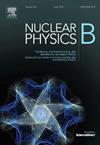Equatorial light bending around a Hairy Kiselev black hole
IF 2.8
3区 物理与天体物理
Q2 PHYSICS, PARTICLES & FIELDS
引用次数: 0
Abstract
We investigate the deflection angle of light rays confined to the equatorial plane of a Hairy Kiselev black hole. The analysis includes a thorough study of the horizon structure and critical parameters, leading to an analytic expression for the deflection angle in terms of elliptic integrals. Our results confirm that the deflection angle decreases with increasing impact parameter, in agreement with classical predictions of gravitational lensing. The influence of the scalar field, characterized by the coupling constant, shows a nontrivial effect: while moderate values of the coupling constant initially enhance light bending, further increases lead to a suppression of the deflection in the strong-field regime due to modifications in spacetime geometry. Comparative analysis among the Schwarzschild, Kiselev, and Hairy Kiselev black holes indicates that the presence of a quintessence-like field tends to enhance the deflection, whereas the scalar hair component reduces it. Further, we investigate the angular shadow radius of the Hairy Kiselev black hole for a static observer and analyze how mass-dependent variations affect the shadow features. These findings underscore the significant role of scalar fields and exotic matter distributions in shaping light propagation in a modified gravity scenario.
赤道光在毛茸茸的基谢列夫黑洞周围弯曲
我们研究了毛状基塞列夫黑洞赤道面的光线偏转角。该分析包括对视界结构和关键参数的深入研究,得到了偏转角的椭圆积分解析表达式。我们的结果证实,偏转角随着撞击参数的增加而减小,这与经典的引力透镜预测一致。以耦合常数为特征的标量场的影响显示出一种非平凡效应:适中的耦合常数值最初会增强光弯曲,但由于时空几何形状的改变,进一步增大会抑制强场区域的偏转。对史瓦西黑洞、基塞列夫黑洞和毛状基塞列夫黑洞的比较分析表明,类精质场的存在倾向于增强偏转,而标量毛分量则会减小偏转。此外,我们研究了毛状基塞列夫黑洞的角阴影半径,并分析了质量相关的变化如何影响阴影特征。这些发现强调了标量场和外来物质分布在改变重力情况下影响光传播的重要作用。
本文章由计算机程序翻译,如有差异,请以英文原文为准。
求助全文
约1分钟内获得全文
求助全文
来源期刊

Nuclear Physics B
物理-物理:粒子与场物理
CiteScore
5.50
自引率
7.10%
发文量
302
审稿时长
1 months
期刊介绍:
Nuclear Physics B focuses on the domain of high energy physics, quantum field theory, statistical systems, and mathematical physics, and includes four main sections: high energy physics - phenomenology, high energy physics - theory, high energy physics - experiment, and quantum field theory, statistical systems, and mathematical physics. The emphasis is on original research papers (Frontiers Articles or Full Length Articles), but Review Articles are also welcome.
 求助内容:
求助内容: 应助结果提醒方式:
应助结果提醒方式:


